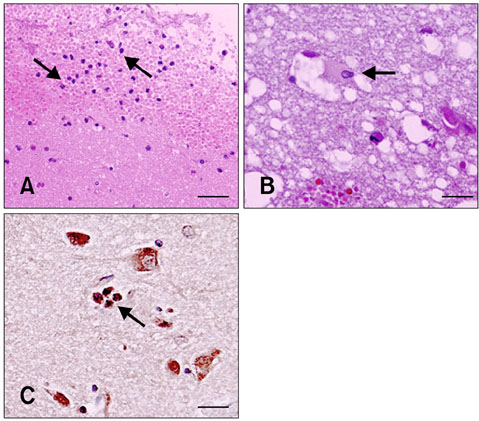J Vet Sci.
2011 Sep;12(3):299-301. 10.4142/jvs.2011.12.3.299.
Pro- and anti-inflammatory cytokine expression and histopathological characteristics in canine brain with traumatic brain injury
- Affiliations
-
- 1Department of Pathobiology, Small Animal Tumor Diagnostic Center, College of Veterinary Medicine, Konkuk University, Seoul 143-701, Korea. jsur@konkuk.ac.kr
- 2Department of Internal Medicine, College of Veterinary Medicine, Gyeongsang National University, Jinju 660-701, Korea.
- 3Department of Medical Imaging, College of Veterinary Medicine, Gyeongsang National University, Jinju 660-701, Korea.
- 4Hyu Animal Clinic, Iksan 570-973, Korea.
- KMID: 1067405
- DOI: http://doi.org/10.4142/jvs.2011.12.3.299
Abstract
- We analyzed the expression level and cellular localization of pro- and anti-inflammatory cytokines and histopathologically characterized canine traumatic brain injury (TBI). Canine TBI brains revealed subarachnoid and cerebral cortical hemorrhage, neutrophilic infiltration, neuronal necrosis, astrocytosis, and vasogenic edema. Immunohistochemical evaluations suggested that both pro-inflammatory cytokines [interleukin (IL)-1beta, IL-6, and tumor necrosis factor-alpha] and anti-inflammatory cytokines [IL-10 and transforming growth factor-beta (TGF-beta)] were highly expressed in neurons and neutrophils. In particular, the highest magnitude of expression was identified for IL-1beta and TGF-beta. This data helps describe the pathologic characteristics of canine TBI, and may help in the design of potential therapeutic approaches to control secondary damage by inflammatory cytokines.
Keyword
MeSH Terms
-
Animals
Brain/*immunology/*pathology
Brain Injuries/immunology/*pathology/*veterinary
Dogs
Humans
Interleukin-10/immunology/metabolism
Interleukin-1beta/immunology/metabolism
Interleukin-6/immunology/metabolism
Transforming Growth Factor beta/immunology/metabolism
Tumor Necrosis Factor-alpha/immunology/metabolism
Figure
Reference
-
1. Allan SM, Rothwell NJ. Cytokines and acute neurodegeneration. Nat Rev Neurosci. 2001. 2:734–744.
Article2. Foley C, Bracker K, Drellich S. Hypothalamic-pituitary axis deficiency following traumatic brain injury in a dog. J Vet Emerg Crit Care (San Antonio). 2009. 19:269–274.
Article3. Fossum T. Small Animal Surgery. 2007. 3rd ed. St. Louis: Mosby;1379–1380. Chap. 37.4. Goss JR, Styren SD, Miller PD, Kochanek PM, Palmer AM, Marion DW, DeKosky ST. Hypothermia attenuates the normal increase in interleukin 1β RNA and nerve growth factor following traumatic brain injury in the rat. J Neurotrauma. 1995. 12:159–167.
Article5. Hayes GM. Severe seizures associated with traumatic brain injury managed by controlled hypothermia, pharmacologic coma, and mechanical ventilation in a dog. J Vet Emerg Crit Care (San Antonio). 2009. 19:629–634.
Article6. Holmin S, Schalling M, Höjeberg B, Nordqvist AC, Skeftruna AK, Mathiesen T. Delayed cytokine expression in rat brain following experimental contusion. J Neurosurg. 1997. 86:493–504.
Article7. Kitagawa M, Okada M, Kanayama K, Sakai T. Traumatic intracerebral hematoma in a dog: MR images and clinical findings. J Vet Med Sci. 2005. 67:843–846.
Article8. Kontos HA, Wei EP. Superoxide production in experimental brain injury. J Neurosurg. 1986. 64:803–807.
Article9. Kossmann T, Stahel PF, Morganti-Kossmann MC, Jones JL, Barnum SR. Elevated levels of the complement components C3 and factor B in ventricular cerebrospinal fluid of patients with traumatic brain injury. J Neuroimmunol. 1997. 73:63–69.
Article10. Laurent S, Thibaud JL, Hordeaux J, Reyes-Gomez E, Delisle F, Blot S, Colle MA. Chronic traumatic brain injury in a dog. J Comp Pathol. 2010. 143:75–80.
Article11. Lynch DR, Dawson TM. Secondary mechanisms in neuronal trauma. Curr Opin Neurol. 1994. 7:510–516.
Article12. McGavin MD, Zachary JF. Pathologic Basis of Veterinary Disease. 2006. 4th ed. St. Louis: Mosby;938–939. Chap. 14.13. Morganti-Kossmann MC, Rancan M, Stahel PF, Kossmann T. Inflammatory response in acute traumatic brain injury: a double-edged sword. Curr Opin Crit Care. 2002. 8:101–105.
Article
- Full Text Links
- Actions
-
Cited
- CITED
-
- Close
- Share
- Similar articles
-
- Animal Models of Traumatic Brain Injury
- Stress, Inflammation and Neurogenesis in Major Depression
- Traumatic Brain injury and Sleep Disorder
- Lysophosphatidic Acid Receptor 1 Plays a Pathogenic Role in Permanent Brain Ischemic Stroke by Modulating Neuroinflammatory Responses
- Clinical Characteristics of Memory Disturbance in Patients with Traumatic Brain Injury Referred for Mental Disabilitiy Evaluation


